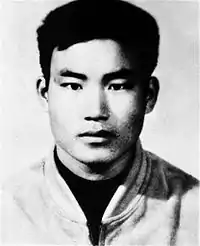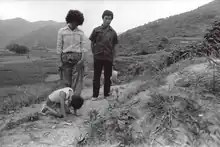Woo Bum-kon | |
|---|---|
| 우범곤 | |
 Undated photo of Woo | |
| Born | Woo Bum-kon March 18, 1955 Pusan, South Gyeongsang, South Korea |
| Died | April 27, 1982 (aged 27) Uiryeong, South Gyeongsang, South Korea |
| Cause of death | Suicide by 2 hand grenades |
| Occupation(s) | Policeman, former South Korean Marine |
| Details | |
| Date | April 26 – 27, 1982 c. 9:30 P.M. – 5:45 A.M. |
| Location(s) | Several villages in Uiryeong County |
| Killed | 63 (including himself) |
| Injured | 35+ |
| Weapons |
|
| Woo Bum-kon | |
| Hangul | 우범곤 |
|---|---|
| Hanja | 禹範坤 |
| Revised Romanization | U Beom-gon |
| McCune–Reischauer | U Pŏmgon |
Woo Bum-kon[lower-alpha 1] (Korean: 우범곤, March 18, 1955 – April 27, 1982) was a South Korean policeman and spree killer who murdered 62 people and wounded around 35 others in several villages in Uiryeong County, South Gyeongsang Province, South Korea, during the night from April 26 to April 27, 1982, before committing suicide.
At the time, Woo's rampage was the worst mass shooting in modern history committed by a single perpetrator, and remains the second deadliest, later surpassed only by the 2011 Norway terrorist attacks. It was also the deadliest deliberate single loss of life in South Korean history until the Daegu Subway Inferno in 2003.
Background
Woo Bum-kon had served in the Republic of Korea Marine Corps, where he was recognized as a skilled marksman until his discharge in 1978.[1] From April 11 until December 30 of 1981, he served as a police officer and, with his marksmanship ability, was able to work as a guard at the Blue House.[2] However, Woo's excessive drinking habits and subsequent behavior caused him to be demoted to his position at Kungyu Village in Uiryeong County, South Gyeongsang Province.[3][4] Woo's girlfriend later said that her boyfriend "suffered from an inferiority complex and had been bothered by villagers' comments on their living together unmarried".[5]
Uiryeong massacre
Prelude
On the afternoon of April 26, 1982, Woo had an argument with his live-in girlfriend, Chun Mal-soon (전말순), after she had woken him by swatting a fly on his chest.[5] Enraged, Woo left the house and went to the police station, where he reported for duty at 4:00 p.m. According to early reports, he began drinking heavily, though eyewitnesses later stated that he did not appear drunk during his rampage. According to local officials, he would have been unable to cover 4 km (2.5 mi) of difficult, rocky terrain while intoxicated.
At about 7:30 p.m., Woo returned home, assaulted his girlfriend and smashed their furniture before making his way to the reservists' armory and gathering several weapons, consisting of two M2 carbines, two handguns, at least 180 rounds of ammunition, and seven hand grenades.[3][5] Some reports stated that the other officers were at a meeting, and he therefore managed to grab the weapons unnoticed,[6] though others mentioned that he had intimidated the guards to gain access.
Rampage begins
At approximately 9:30 p.m., Woo shot his first victim and entered the local post office, where he killed three phone operators and cut off the telephone lines.[7] He next went to Torongni, where he threw a grenade and shot at passers-by in the marketplace, killing six people. He also wounded Chun Mal-soon, who had gone to investigate after hearing shots in the village.[7] From that point on, he proceeded from village to village, taking advantage of his position as a police officer to gain entry to the houses and shoot their inhabitants.
At 10:30 p.m., Woo took 18-year-old Kim Ju-dong (김주동) hostage and moved to Ungye-Ri (운계리), where he ordered Kim to get him a soft drink from a grocery store owned by 52-year-old Shin We-do (신외도). After getting what he had asked for, Woo killed Kim and then attacked the store owner and his family. Shin We-do managed to escape after being shot in the leg, though his wife Son Won-jeom (손원점) and his daughters Chang-sun (창순) and Su-jeong (수정) were killed.[8] Woo continued his shooting at the market-place, killing a total of 18 people in that village, before making his way towards Pyongchon-Ni (평촌리).[4][8]
At Pyongchon-Ni, he shot a family of four in their beds and then went to another house where the owner was awake. When the owner of the house saw the armed policeman and asked what had happened, Woo explained that there was an alert as North Korean agents had been spotted. The man invited Woo into the house for dinner, during which the latter complained about his small salary and his transfer from Pusan to the countryside. Woo eventually began shooting at the guests after one of them had remarked that his ammunition did not look real. He killed twelve people in the house and a further eight in the streets, thus leaving a total of 24 people dead in Pyongchon-ni.
Police response, suspect's death
Although police were alerted within minutes of the first shots being fired, it took them an hour to gather a team of 37 officers to search for the gunman, and the national police headquarters in Seoul were not informed until 1:40 a.m.[9] Around that time, just 4 km (2.5 mi) from the police station in Kungryu, Woo found refuge in a farmhouse belonging to 68-year-old Suh In-Su (서인수), whom he told that he was chasing a Communist infiltrator, and that the family should gather in the main room of the house so he could protect them. When the family gathered at his request, he held them hostage.
Two hours later, police eventually caught up with him, and as forces closed in, Woo strapped two grenades to his chest and detonated them, killing himself and three of his hostages. Suh himself survived gravely injured.[10] Four rounds of ammunition and one hand grenade were recovered by police from inside the farmhouse.[8]
Immediate aftermath
When the rampage finally ended, 55 people and Woo himself were dead, while around 42 others were wounded. Six of the injured later died from their injuries, including a child who died on May 8. At that time, the injured were being treated in hospitals in Jinju and Masan.[11][12]
Later on, the provincial chief of police was suspended and four other officers were arrested for negligence of duty.[1][7]

Aftermath
The Interior Minister of South Korea, Suh Chung-hwa, and the national police chief, A Eung-mo, offered to resign as a form of atonement for Woo's rampage.[1] Suh Chung-hwa, being held responsible for the incident by president Chun Doo-hwan, resigned his commission on April 29, and Roh Tae-woo was appointed Interior Minister.[13][9]
A special parliamentary team was formed, consisting of 19 parliamentarians and led by Home Affairs Committee chairman Kim Chong-hoh, to investigate the massacre and its disastrous handling by the police.[9] Furthermore, the South Korean Cabinet decided to pay compensations to the victims and their families.[14]
The death toll of the massacre is disputed from source to source. 57 people were confirmed dead initially, and 6 were later confirmed dead due to related injuries, but some South Korean sources state that the death toll may have risen to at least 75 after multiple injured victims succumbed to their wounds. Despite the conflicting reports on the death toll, the injury count consistently remains around 35 or more from all available sources.[15]
At the time, Woo's rampage was the worst mass shooting in modern history committed by a single perpetrator, and remains the second deadliest, later surpassed only by the 2011 Norway terrorist attacks.[16][17] It was also the deadliest deliberate single loss of life in South Korean history until the Daegu subway fire in 2003.
See also
Notes
- ↑ Alternatively transliterated as Wou Bom-kon
References
- 1 2 3 "Cop kills 55 after quarrel with mistress". New Straits Times. April 28, 1982. p. 1 – via Google News Archive.
- ↑ 동아일보, April 28, 1982, p. 7
- 1 2 "Berserk Korean policeman kills 62". Gainesville Sun. Vol. 106, no. 295. AP. April 27, 1982. p. 14A – via Google News Archive.
- 1 2 "28명 죽이고 초상집 문상… 부의금 3000원 낸 뒤 또 난사". The Hankyoreh (in Korean). April 13, 2012. Archived from the original on April 15, 2012.
- 1 2 3 "Wife says deranged policeman was 'hard to please'". United Press International. April 28, 1982. Retrieved November 11, 2022.
- ↑ "Berserk South Korea cop slays total of 56 people". Lodi News-Sentinel. No. 13432. UPI. April 28, 1982. p. 3 – via Google News Archive.
- 1 2 3 "Seoul is stunned by policeman's slaying of 56". The New York Times. April 28, 1982. p. 5.
- 1 2 3 "Korean policeman's rampage leaves 58 dead". The Daily Union. No. 159. AP. April 27, 1982. p. 8 – via Google News Archive.
- 1 2 3 "Minister sacked over massacre". New Straits Times. UPI. April 29, 1982. p. 1 – via Google News Archive.
- ↑ Ricochet from a rampage. Far Eastern Economic Review. May 7, 1982.
- ↑ "Murder toll rises to 56". The Straits Times. AP. May 10, 1982. p. 3 – via NewspaperSG.
- ↑ "사망자 56·부상 35명|일부 사망자수 중복…집계 엇갈려". JoongAng Media Network Group (in Korean). April 28, 1982. Archived from the original on August 13, 2017.
- ↑ "South Korean Shootings Lead Minister to Resign". The New York Times. April 29, 1982. p. 9.
- ↑ "Victims of amok slayings to get compensation". New Straits Times. April 30, 1982. p. 15 – via Google News Archive.
- ↑ "Namu Wiki (source of newspaper)".
- ↑ "Norway massacre 'work of a madman'". Irish Examiner. July 23, 2011.
- ↑ "Death toll in rampage put at 62". The Age. Vol. 128. April 28, 1982. p. 16. Retrieved March 22, 2023 – via Google News Archive.
Further reading
- Hwang, K.C (April 27, 1982). "Korean policeman goes berserk, uses carbines, grenades to kill 58, self". The Madison Courier. AP. p. 8 – via Google News Archive.
- "Korean cop's rampage leaves 58 dead". Ocala Star-Banner. Vol. 38. AP. April 27, 1982 – via Google News Archive.
- "Korean policeman's rampage kills 58". Boca Raton News. Vol. 27, no. 126. AP. April 27, 1982. p. 5A – via Google News Archive.
- Hwang, K.C. (April 27, 1982). "Drunken South Korean policeman kills 62". The Ledger. Vol. 76, no. 187. AP. p. 6A – via Google News Archive.
- "Berserk cop kills 53". Ellensburg Daily Record. Vol. 81, no. 99. UPI. April 27, 1982. p. 1 – via Google News Archive.
- "Korean cop massacres 58". Eugene Register-Guard. Vol. 115, no. 186. AP. April 27, 1982. p. 1 – via Google News Archive.
- "Korean massacre area flooded with donations". Eugene Register-Guard. Vol. 118, no. 187. AP. April 28, 1982. p. 5A – via Google News Archive.
- Hwang, K.C. (April 27, 1982). "Drunken Korean kills 58". The Free Lance-Star. Vol. 98, no. 99. AP. p. 1 – via Google News Archive.